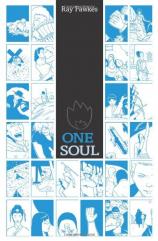One Soul
Review
One Soul
Ray Fawkes has innovatively constructed a linear narrative that often defies the confines of linear story progression through the form and design of One Soul. Organized into nine panels per page on a three-by-three grid layout, One Soul devotes only one panel per page to a specific, nameless character. While the structure may elicit a rather simplistic and repetitive panel system for some, the result is, in effect, 19 different ways for readers to experience the text. Thus, for example, if audiences chose only to read the story of the boy abandoned at a local monastery, they could read the second panel on the odd- numbered pages. This approach can be repeated for all 18 tales or the book can be read as a whole. Both methods have their distinct strengths and limitations.
As Fawkes revealed to me, the "concept and structure of One Soul were both born of the unique strengths of graphic storytelling, in particular the opportunity to play with the dimensions of time and space, both on a single page and in a series of pages." In essence, this is a project that could only be done through the sequential medium since overlapping, simultaneous stories intersecting alongside one another while also running parallel in their development would be virtually impossible in cinema or traditional novel forms. This comes through quite well on the pages as audiences witness the largely equal, universal experiences shared by all of the characters during the story's inception, and then evolve and mature along with the characters themselves. Furthermore, because Fawkes utilizes a repeated grid layout throughout the book, the events and incidents hold greater value and impact for readers as time moves and passes in perfect unison. As a result, each of the individual panels forms a significant element within the pattern guiding the entire project.
The congregation of nameless characters working within the collective, thematic infrastructure Fawkes has built inevitably results in some of the singular episodes being subsumed by the sheer force of the larger canvas he is examining. At the same time, the "big picture" can be forgotten as a reader becomes engrossed in a single character or perhaps even two or three key figures who stand out. Ultimately, however, Fawkes has invested the unnamed with such empathy and intrigue that their individual lives become the microcosm for the greater experiment he is creating. This is a testament to Fawkes’ narrative abilities.
Visual storytelling is obviously one of Fawkes' strong suits and not just in his layouts and scripting abilities, but also in his black-and-white line art. One of the most impressive aspects of Fawkes' illustrations is how he plays with not only the shadows and elements of gray that are not immediately apparent upon first glance, but also the variety of weights he gives the lines themselves to create and reinforce the overall atmosphere and mood he is seeking. Similarly, perspective and guiding lines are also so subtly interwoven into the panel foreground elements and background settings that some readers may not grasp just how connected the panels truly are until they step back and look at the completed page. Although apparent on the side-by-side layout below, taken a page at a time, the stark contrast between black and white assumes a life of its own in the progression of the story and its composition:
It is difficult to grasp just how complicated and complex Fawkes' process was for this book, but it pays off on nearly every page.
One Soul demands more from its readers than the usual genre fare that occupies the majority of the graphic marketplace. It is also a text, I believe, that will be better suited to print than digital formats because of the individualized and varied approaches readers can have with the novel. Fawkes, along with Oni Press, should be commended on both fronts for taking such a daring and experimental concept and giving it substance and a stage. Apart from its artistic and literary merits, One Soul also has importance for students of sequential art and the graphic medium itself because it would make for an excellent source of classroom discussion and debate regarding Fawkes' methodologies. If Oni can do only one thing to improve the presentation of One Soul, it would be the inclusion of an in-depth creator interview with Fawkes (something from which this reviewer benefited greatly on a much smaller scale), outlining his process and approach.
Reviewed by Nathan Wilson on July 10, 2012
One Soul
- Publication Date: July 20, 2011
- Genres: Graphic Novel
- Hardcover: 176 pages
- Publisher: Oni Press
- ISBN-10: 1934964662
- ISBN-13: 9781934964668




